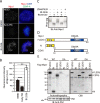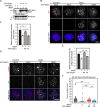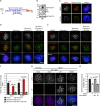Plk1 bound to Bub1 contributes to spindle assembly checkpoint activity during mitosis
- PMID: 28821799
- PMCID: PMC5562746
- DOI: 10.1038/s41598-017-09114-3
Plk1 bound to Bub1 contributes to spindle assembly checkpoint activity during mitosis
Abstract
For faithful chromosome segregation, the formation of stable kinetochore-microtubule attachment and its monitoring by the spindle assembly checkpoint (SAC) are coordinately regulated by mechanisms that are currently ill-defined. Here, we show that polo-like kinase 1 (Plk1), which is instrumental in forming stable kinetochore-microtubule attachments, is also involved in the maintenance of SAC activity by binding to Bub1, but not by binding to CLASP2 or CLIP-170. The effect of Plk1 on the SAC was found to be mediated through phosphorylation of Mps1, an essential kinase for the SAC, as well as through phosphorylation of the MELT repeats in Knl1. Bub1 acts as a platform for assembling other SAC components on the phosphorylated MELT repeats. We propose that Bub1-bound Plk1 is important for the maintenance of SAC activity by supporting Bub1 localization to kinetochores in prometaphase, a time when the kinetochore Mps1 level is reduced, until the formation of stable kinetochore-microtubule attachment is completed. Our study reveals an intricate mechanism for coordinating the formation of stable kinetochore-microtubule attachment and SAC activity.
Conflict of interest statement
The authors declare that they have no competing interests.
Figures





Similar articles
-
Cdk1 and Plk1 mediate a CLASP2 phospho-switch that stabilizes kinetochore-microtubule attachments.J Cell Biol. 2012 Oct 15;199(2):285-301. doi: 10.1083/jcb.201203091. Epub 2012 Oct 8. J Cell Biol. 2012. PMID: 23045552 Free PMC article.
-
Interactions between N-terminal Modules in MPS1 Enable Spindle Checkpoint Silencing.Cell Rep. 2019 Feb 19;26(8):2101-2112.e6. doi: 10.1016/j.celrep.2019.01.017. Cell Rep. 2019. PMID: 30784592
-
Phosphorylation- and polo-box-dependent binding of Plk1 to Bub1 is required for the kinetochore localization of Plk1.Mol Biol Cell. 2006 Aug;17(8):3705-16. doi: 10.1091/mbc.e06-03-0240. Epub 2006 Jun 7. Mol Biol Cell. 2006. PMID: 16760428 Free PMC article.
-
Orchestration of the spindle assembly checkpoint by CDK1-cyclin B1.FEBS Lett. 2019 Oct;593(20):2889-2907. doi: 10.1002/1873-3468.13591. Epub 2019 Sep 13. FEBS Lett. 2019. PMID: 31469407 Review.
-
Recent Progress on the Localization of PLK1 to the Kinetochore and Its Role in Mitosis.Int J Mol Sci. 2022 May 8;23(9):5252. doi: 10.3390/ijms23095252. Int J Mol Sci. 2022. PMID: 35563642 Free PMC article. Review.
Cited by
-
Phosphatases in Mitosis: Roles and Regulation.Biomolecules. 2019 Feb 7;9(2):55. doi: 10.3390/biom9020055. Biomolecules. 2019. PMID: 30736436 Free PMC article. Review.
-
Lateral attachment of kinetochores to microtubules is enriched in prometaphase rosette and facilitates chromosome alignment and bi-orientation establishment.Sci Rep. 2018 Mar 1;8(1):3888. doi: 10.1038/s41598-018-22164-5. Sci Rep. 2018. PMID: 29497093 Free PMC article.
-
The CINs of Polo-Like Kinase 1 in Cancer.Cancers (Basel). 2020 Oct 13;12(10):2953. doi: 10.3390/cancers12102953. Cancers (Basel). 2020. PMID: 33066048 Free PMC article. Review.
-
A bifunctional kinase-phosphatase module balances mitotic checkpoint strength and kinetochore-microtubule attachment stability.EMBO J. 2023 Oct 16;42(20):e112630. doi: 10.15252/embj.2022112630. Epub 2023 Sep 15. EMBO J. 2023. PMID: 37712330 Free PMC article.
-
PLK1 in cancer therapy: a comprehensive review of immunomodulatory mechanisms and therapeutic opportunities.Front Immunol. 2025 Jun 19;16:1602752. doi: 10.3389/fimmu.2025.1602752. eCollection 2025. Front Immunol. 2025. PMID: 40612941 Free PMC article. Review.
References
Publication types
MeSH terms
Substances
LinkOut - more resources
Full Text Sources
Other Literature Sources
Molecular Biology Databases
Research Materials
Miscellaneous

